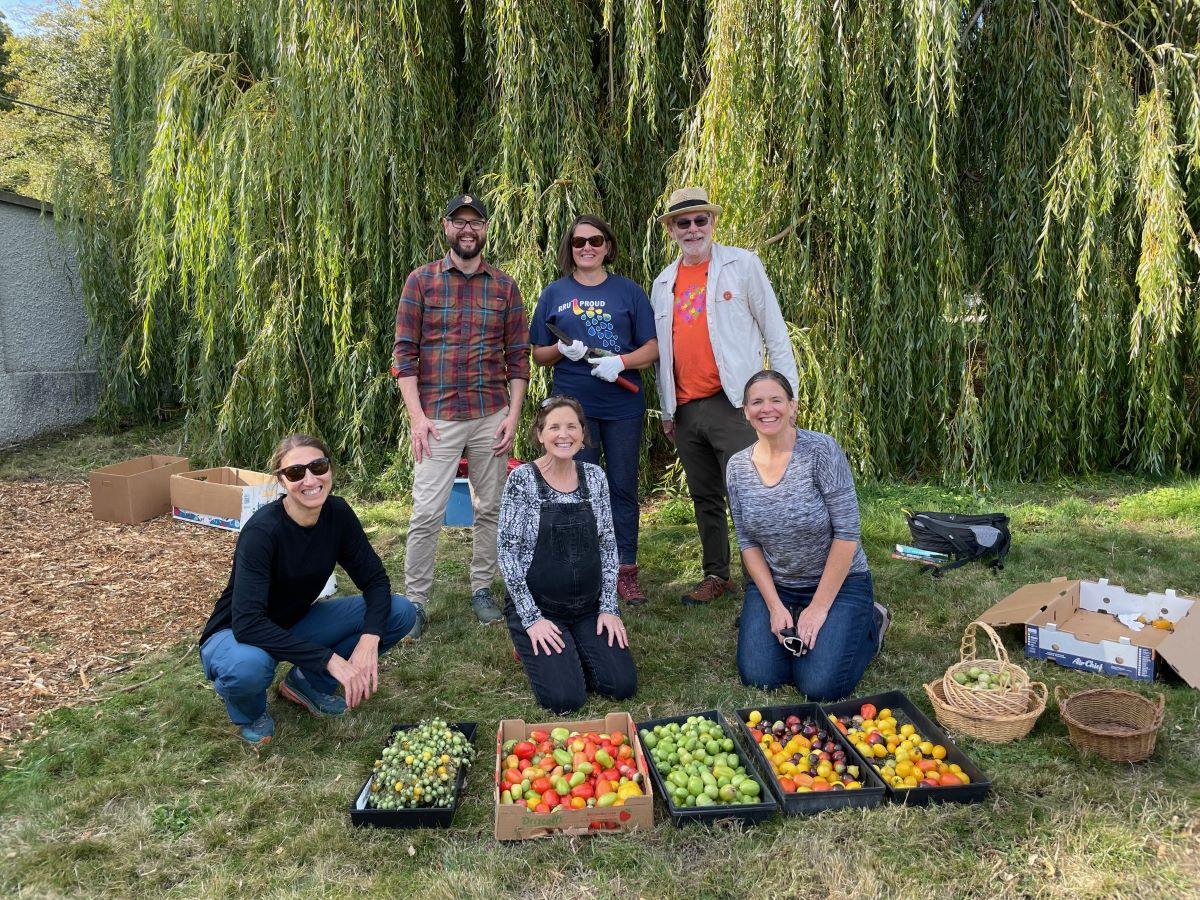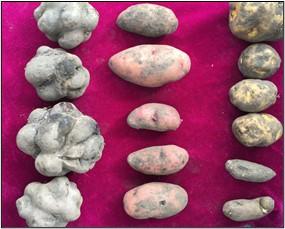Cultivating Biodiversity as Climate Action Leadership: What We Can Learn from Potatoes
Featured
Share online

On October 3rd, members of the School of Leadership Studies (SLS) volunteered in RRU’s Giving Garden. Under the leadership of Food Systems Manager and Masters of Arts in Environmental Education and Communication (MAEEC) student, Solara Goldwynn, SLS faculty and staff learned lessons on the importance of biodiversity through picking apples (King and Blenheim Orange varieties), sorting squash—especially Butter Bush squash, grown from seeds donated by Marsha at Eagleridge seeds on Salt Spring Island, BC—and wondering at the bountiful crop of Ozette potatoes. More info on the Ozette here.
Why Biodiversity Matters
In her 1993 book, “Monocultures of the Mind”, physicist, food sovereignty activist, and environmental scholar, Dr. Vandana Shiva, famously wrote about the significance of biodiversity in climate justice and food security. Monocultures—either of scientific thought or food crops—are vulnerable to the changing climate, unsustainable, and serve to oppress, negate, or erase local, Indigenous peoples and knowledges that have sustained people the world over for millennia. Respecting and intentionally cultivating diversity—in food, people, cultures, practices, knowledges, and even financial portfolios—puts us on a path of flourishing, adaptability, peaceful co-existence, and sustainability.
In this post, Master of Arts in Environment and Management (MEM) student, Emily Townsend (2023), shares what she has learned about potatoes from her recent Master’s research in Ecuador.
Global Success of Potato
Potato (Solanum tuberosum), native to the South American Andes, is a globally successful crop due to its highly adaptable, high-yielding, and nutrient-rich properties (DeFauw et al., 2012). Its unique traits have allowed it to be disbursed throughout the world in varied landscapes and climatic environments, improve diets and food security, and enhance economic opportunities (DeFauw et al., 2012). Global production of the potato plays an important role in global food security by helping reduce undernourishment through its ease of cultivation and high nutritional content. Potato cultivation in small communities also serves as an economic opportunity by acting as a local cash crop for low-income families (DeFauw et al., 2012). Although its versatility has allowed the crop to flourish throughout the world in both the Global South and Global North, the potato continues to have considerable intraspecific diversity, and to be of rich cultural and traditional importance in its center of origin: the Andes (Parra-Rondinel et al., 2021).
Origin of Potato in the Andes
Andean potato cultivars have been maintained in the Andean region for millennia, through domestication and cultivation techniques transferred over time by intergenerational Traditional Knowledge within Andean communities (Parra-Rondinel et al., 2021; Pomboza-Tamaquiza et al., 2016). Andean potato biodiversity hotspots include Peru, Bolivia, and Ecuador, where cultivation of the crop continues to be extensive. These three countries constitute one bioregion, defined as an area that shares similar topography, flora and fauna, and human culture (Harris et al., 2016). In this bioregion, farmers have adopted similar practices and understandings of Andean potato and currently face comparable socio-economic and environmental challenges growing and selling the crop (Devaux et al., 2020).
Maintaining an array of potato cultivars plays an essential role in supporting present Andean community livelihoods and the ongoing evolution of genetic diversity for the future of our vulnerable food systems (de Haan et al., 2010; Zimmerer, 1991). The vast potato biodiversity that exists in the Andean region is due to gene flow, mutations, and human selection that has been maintained through thousands of years by human societies. Gene flow has occurred through locally adapted potato varieties that have been cultivated near, and pollinated with, their wild relatives. This has allowed gene flow and mutations in potato to result in a multitude of cultivars, exhibiting great intraspecific diversity (de Haan et al., 2010).
Decline of Andean Potato Cultivars
In the 1970s, the emergence of the so-called green revolution and agricultural modernization began impacting traditional Andean agriculture. Traditional production systems and ancestral agricultural knowledge in the Andean region were disrupted as modern practices were introduced. Throughout the green revolution, technologies such as synthetic fertilizers and pesticides, hybrid seeds, and mechanization, started to replace low-impact, low-input, traditional manual labour agriculture (Pomboza-Tamaquiza et al., 2016). In the last 20 to 30 years, this has led to intensive potato monocropping becoming common practice in Ecuador (Monteros-Altamirano, 2018; Pomboza-Tamaquiza et al., 2016). In a study conducted within two rural communities in the province of Tungurahua, Ecuador, farmers predominantly used monoculture practices for their potato cultivation. In the two communities studied, Puñachisag and Apatug, 71% and 59% of farmers, respectively, maintained monocultures for their potato cultivars, demonstrating a predominance in monoculture practices over traditional agricultural practices (Pomboza-Tamaquiza et al., 2016). Even as agricultural modernization conferred some advantages such as higher yields, it resulted in negative consequences on local social and environmental conditions as well. These include overexploited soils, weakened genetic resources, and disrupted Indigenous traditions (Pomboza-Tamaquiza et al., 2016).
Pressures to the cultivation and preservation of diverse Andean potato cultivars go beyond the influence of modern agriculture and climate change and range from global food market dynamics to individual shifting consumer preferences (Lüttringhaus et al., 2012). The Andes remain a biodiversity hotspot for Andean potato cultivars, cultivation and preservation of the crop is declining among Andean farmers (Bellon et al., 2015; Monteros-Altamirano, 2018) due to the changing climate creating changing growing conditions; a reduction in intergenerational knowledge transmission resulting in lowered literacy in traditional ecological knowledges, and a limited market demand for what is perceived by consumers as ugly potatoes.

Benefits of Diverse Andean Potato Cultivars
There is a direct relationship between biodiversity and nutrition (de Haan et al., 2019). Andean potato genotypes show the widest diversity in shape, flesh and skin color, texture, and flavour, which studies suggest have higher nutritional and bioactive compound contents. Compared to the widely consumed commercial potato, usually white or yellow, Andean potato cultivars have shown to have significantly more health benefits, often attributed to their flesh and skin colour, and growing environment. Some of these benefits include high levels of antioxidant phenolic compounds in red and purple potato cultivars, and essential nutrients such as iron, zinc, calcium, carotenoids, and Vitamin C and B in native Andean potato cultivars (Andre et al., 2007; Bellumori et al., 2020; de Haan et al., 2019). Studies suggest that greater nutrient composition may also be attributed to the soil and environment in which Andean potatoes are cultivated, in low-temperature and high-altitude environments (Andre et al., 2007; Bellumori et al., 2020).
What You Can Do
Here are a few ways you can take action:
- Support local farmers.
- Begin your own garden.
- Be intentional in your choice of seeds, selecting organic, local seeds that have been cultivated to survive in your bioregion and climate.
- Eat the “ugly potato” or produce that might otherwise go to waste.
- Notice where a monoculture mindset shows up in different aspects of your life. From your eating habits and your workplace, look to diversity to enhance flourishing, adaptability, peaceful co-existence, and sustainability.
If your team or class is interested in volunteering in RRU’s Giving Garden, please contact Solara.1goldwynn@royalroads.ca
Click here to learn more about RRU’s Master of Arts in Climate Action Leadership (MACAL).
References
Andre, C. M., Ghislain, M., Bertin, P., Oufir, M., Herrera, M. R., Hoffmann, L., Hausman, J.-F., Larondelle, Y., & Evers, D. (2007). Andean potato cultivars (Solanum tuberosum L.) as a source of antioxidant and mineral micronutrients. Journal of Agricultural and Food Chemistry, 55(2), 366–378. https://doi.org/10.1021/jf062740i
Bellumori, M., Chasquibol Silva, N. A., Vilca, L., Andrenelli, L., Cecchi, L., Innocenti, M., Balli, D., & Mulinacci, N. (2020). A study on the biodiversity of pigmented Andean potatoes: Nutritional profile and phenolic composition. Molecules, 25(14), 3169. https://doi.org/10.3390/molecules25143169
De Haan, S., Burgos, G., Liria, R., Rodriguez, F., Creed-Kanashiro, H. M., & Bonierbale, M. (2019). The nutritional contribution of potato varietal diversity in Andean food systems: A case study. American Journal of Potato Research, 96, 151–163. https://doi.org/10.1007/s12230-018-09707-2
De Haan, S., Nuñez, J., Bonierbale, M., & Ghislain, M. (2010). Multilevel agrobiodiversity and conservation of Andean potatoes in Central Peru: Species, morphological, genetic, and spatial diversity. Mountain Research and Development, 30(3), 222–231. https://doi.org/10.1659/MRD-JOURNAL-D-10-00020.1
Defauw, S. L., He, Z., Larkin, R. P., & Mansour, S. A. (2012). Sustainable potato production and global food security. Sustainable Potato Production: Global Case Studies, 3–19. https://doi.org/10.1007/978-94-007-4104-1_1
Devaux, A., Hareau, G., Ordinola, M., Andrade-Piedra, J., & Thiele, G. (2020). Native potatoes: From forgotten crop to culinary boom and market innovation. Choices. https://www.researchgate.net/publication/349177271
Harris, G., Nixon, D., Newman, L., Mullinix, K. (2016). Delineating the Southwest British Columbia bioregion for food system design and planning: A practical approach. Journal of Agriculture, Food Systems, and Community Development, 6(4), https://doi.org/10.5304/jafscd.2016.064.010
Lüttringhaus, S., Pradel, W., Suarez, V., Manrique-Carpintero, N. C., Anglin, N. L., Ellis, D., Hareau, G., Jamora, N., Smale, M., & Gómez, R. (2021). Dynamic guardianship of potato landraces by Andean communities and the genebank of the International Potato Center. CABI Agriculture and Bioscience 2021 2:1, 2(1), 1–16. https://doi.org/10.1186/S43170-021-00065-4
Monteros-Altamirano, Á. (2018). On-farm conservation of potato landraces in Ecuador. Agronomía Colombiana, 36(3), 189–200. https://doi.org/10.15446/agron.colomb.v36n3.66640
Parra-Rondinel, F., Casas, A., Begazo, D., Paco, A., Márquez, E., Cruz, A., Segovia, J., Torres-García, I., Zarazúa, M., Lizárraga, L., & Torres-Guevara, J. (2021). Natural and Cultural Processes Influencing Gene Flow Among Wild (atoq papa), Weedy (araq papa and k’ipa papa), and Crop Potatoes in the Andean Region of Southern Peru. Frontiers in Ecology and Evolution, 9, 1–8. https://doi.org/10.3389/FEVO.2021.617969/BIBTEX
Pomboza-Tamaquiza, P. P., Paucar, D., Cruz Tobar, S. E., Núñez Torres, O.P., & Velástegui Espín, G.P. (2016). Ancestral practices in potato (Solanum tuberosum L.) crop of two rural communities in the Tungurahua province of Ecuador. Acta Agronómica, 66(2), 157–163. https://doi.org/10.15446/acag.v66n2.58895
Shiva, V. (1993). Monocultures of the mind: Perspectives on biodiversity and biotechnology. Zed Books.
Townsend, E. (2023). Co-beneficial strategies to increase Andean potato cultivation and preservation in Ecuador. [Unpublished Master’s Thesis.] Royal Roads University.
Zimmerer, K. S. (1991). The Regional Biogeography of Native Potato Cultivars in Highland Peru. Journal of Biogeography, 18(2), 165–178. https://doi.org/10.2307/2845290
Photo Credits
Top Photo, bottom row from left to right: Wanda Krause, Cheryl Heykoop, Sherry Richards. Top row from left to right: Steve Miles-Berry, Catherine Etmanski, Niels Agger-Gupta. Photo by Solara Goldwynn in RRU’s Giving Garden. October 3, 2023.
Second photo: Nine washed Andean potato cultivars collected August 2, 2022, in Chimborazo, Ecuador, showing morphological and colour variation. Photo by Emily Townsend.
Gratitude
Thanks to Sherry Richards and Solara Goldwynn for organizing for the SLS team to volunteer in the garden.